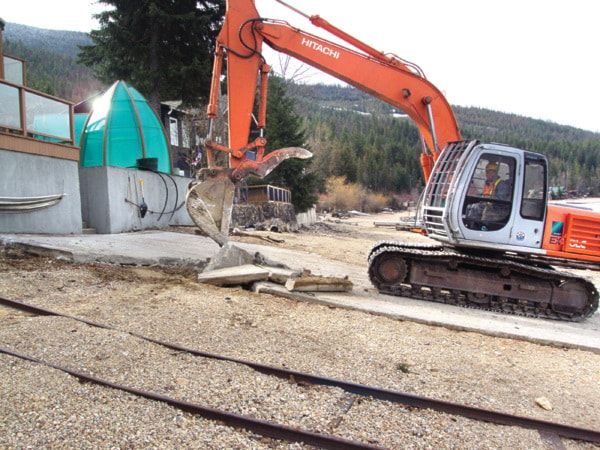Shuswap Lake foreshore restoration may be part of an award-winning project, but not everyone is handing out accolades.
With a detailed water-quality monitoring program underway and close to $100,000 in funding from the province’s Habitat Conservation Trust Foundation, the Shuswap Lake Integrated Planning Process (SLIPP) has begun implementing a series of shoreline restoration projects.
Hoping waterfront landowners will be willing to collaborate, SLIPP is funding restoration projects in critical fish habitat.
Work began on Annis Bay last week, with the removal of large concrete boat ramps and a massive rock groyne.
“SLIPP is paying for these restorations because we want to raise awareness about the importance of fish habitat,” says Sarah Evanetz, SLIPP program manager, who notes about a dozen people in the areas of most valuable fish habitat were offered this one-time voluntary opportunity. “We needed to get approvals in advance and have been working closely with landowners.”
But SLIPP officials are very clear that landowners who do not willingly engage in restoration projects will be subject to enforcement.
That rankles Annis Bay resident Glen Pilling, one of the property owners who refused to participate in the one-time offer and have a cement ramp removed from the foreshore in front of his property.
Pilling says officials told him last August that his ramp is in critical fish habitat, something he disputes because he says the lake level is always well below the ramp when trout spawn in the fall.
As well, he says, a SLIPP map indicates that critical fish habitat ends about 50 metres east of his ramp.
Pilling says the 60-acre parcel was purchased by his father and grandfather in about 1956 and the ramp has been there since about 1965.
“We call it a swimming ramp, we use it for swimming because the beach is so rocky, and for launching boats,” he says, noting some 50 adults and children enjoy the use of the ramp.
There are seven residences on the property, with a total of 21 approved, and boat access is an important part of being able to market the property, says Pilling, who points out without the ramp, owners would have to drive to Sicamous to put their boats in the water.
“We got a land-use contract with the regional district, which was finalized around 1987 and they knew all about the uses, including the ramp.”
Marcin Pachcinski, Columbia Shuswap Regional District Parks and Recreation team leader, says a bylaw to regulate docks and buoys has been given third reading by the board and is in Victoria for consideration.
“We did work with them to accommodate their land-use contract,” says Pachcinski, noting that in the past, the property was given a spot zone and that he held two or three meetings with the family. “We wanted to treat them fairly. In the lake zoning bylaw they have a site-specific density that will allow for one buoy per home on the property. It’s what they wanted.”
Ray Nadeau, president of the Shuswap Water Action Team (SWAT) and representative on two of the public advisory committees, says spawning is not the only issue.
He says once the fry hatch, they migrate around the lake, and need areas in which to escape bigger predators.
Input into foreshore restoration came from a cross-section of businesses, landowners, waterfront owners and elected representatives.
“There’s been a lot done over the years and 60 per cent of the habitat is no longer there for the fish,” he says. “It is unusual to have a program that actually tries to go back and repair things and correct damage that’s been done. The reason to do it was that it was always against regulations, but there was just a blind eye turned on it.”
A plethora of man-made structures on foreshore Crown land was identified as a top-priority issue six years ago when a number of government officials, First Nations reps and others toured the lake by houseboat.
“Shuswap shorelines are critical to a sustainable environment, the water quality we depend on for our drinking water and recreation, the regional economy and important fish and wildlife habitats,” says Ted Bacigalupo, chair of the SLIPP steering committee and the board of directors of the Columbia Shuswap Regional District. “We all share the responsibility for keeping our shorelines healthy.”
